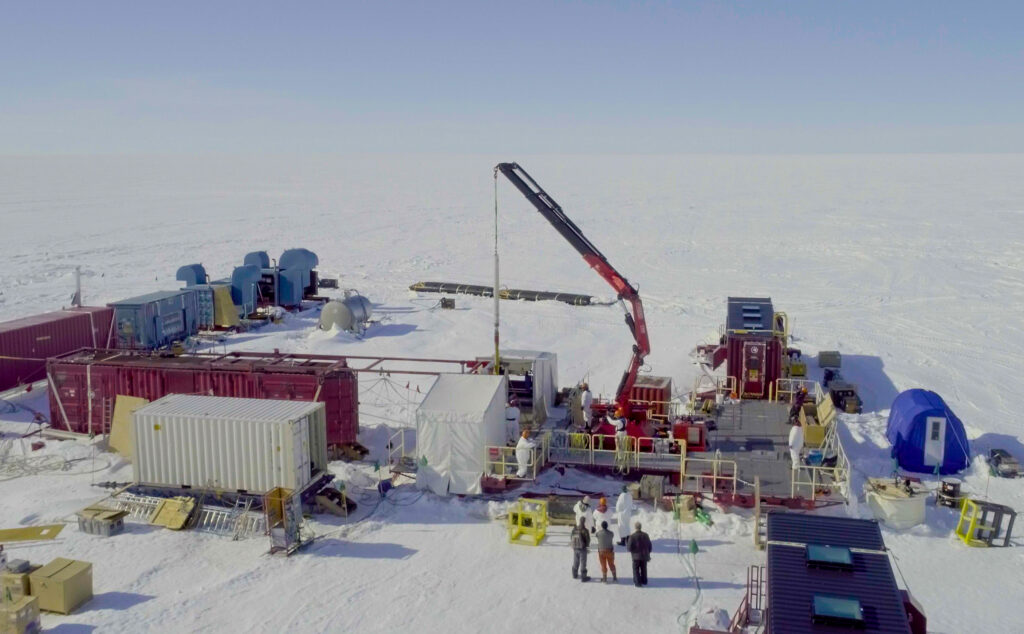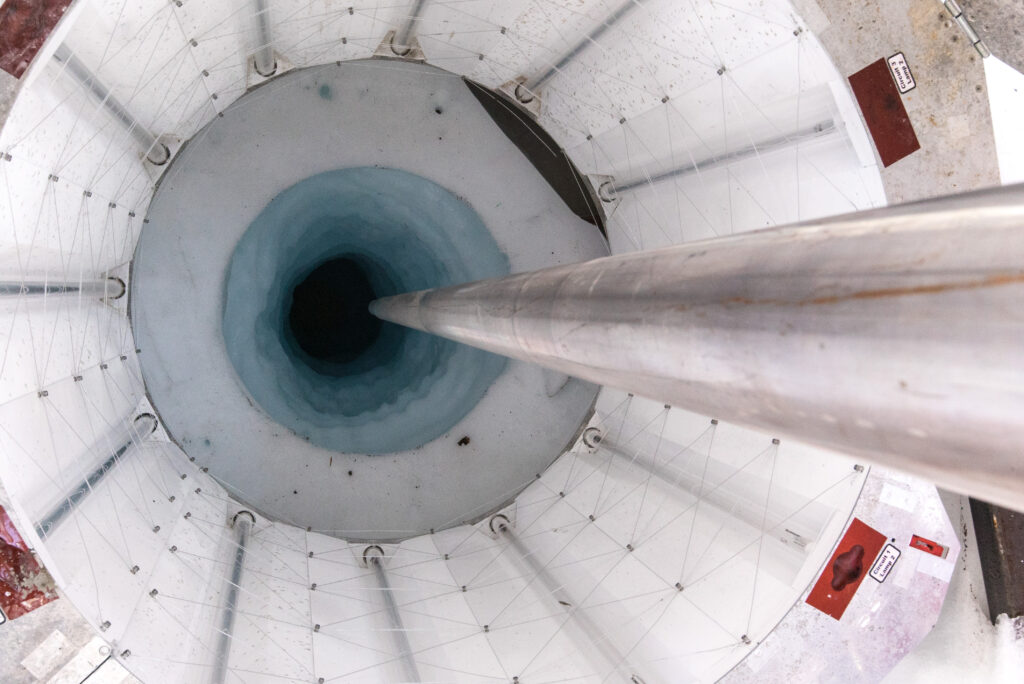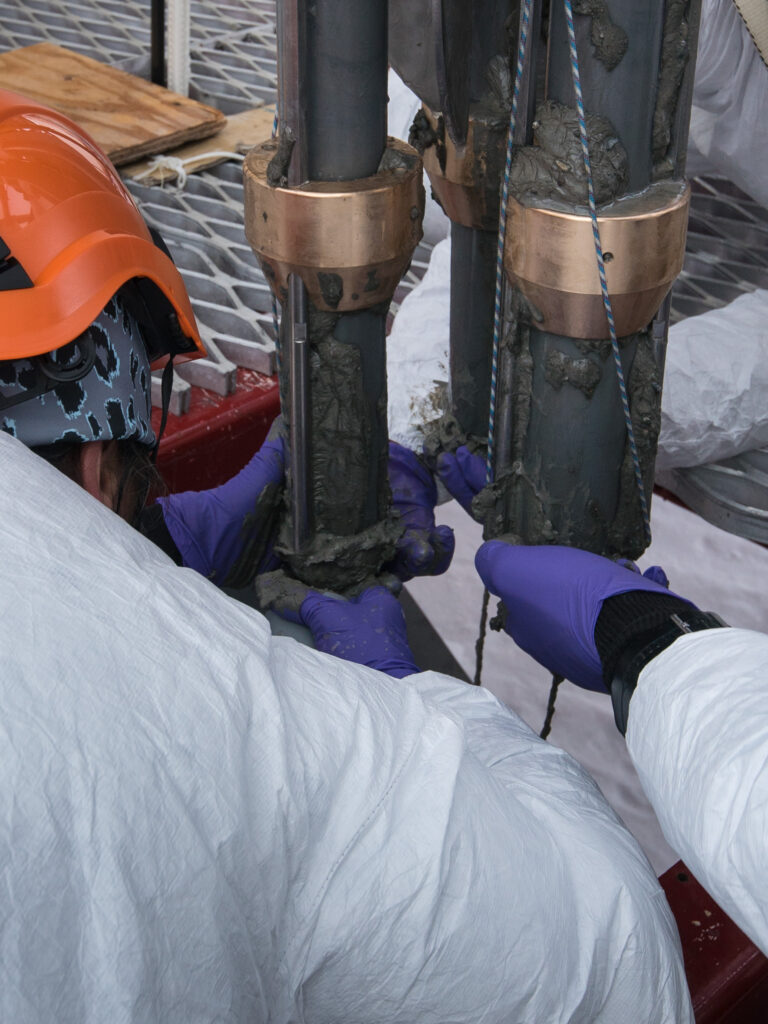A lake under a kilometer of ice preserves the ice sheet’s past, hints at possibility of advancing even after large-scale retreat
1 May 2023

The West Antarctic Ice Sheet retreated at least 250 kilometers (160 miles) inland of where the ice meets the ocean today, then re-advanced, according to new research published in AGU Advances. Scientists traced the ice’s movement using sediments from a lake more than 1 kilometer (0.6 miles) under the ice, sampled using the corer in this photo. Credit: Billy Collins
AGU press contact:
Liza Lester, [email protected], +1 (202) 777-7494 (UTC-4 hours)
Contact information for the researchers:
Ryan Venturelli, Colorado School of Mines, [email protected] (UTC-7 hours)
WASHINGTON — The West Antarctic Ice Sheet is melting rapidly, raising concerns it could cross a tipping point of irreversible retreat in the next few decades if global temperatures rise 1.5 to 2.0 degrees Celsius (2.7 to 3.8 degrees Fahrenheit) above preindustrial levels. New research finds that 6,000 years ago, the grounded edge of the ice sheet may have been as far as 250 kilometers (160 miles) inland from its current location, suggesting the ice retreated deep into the continent after the end of the last ice age and re-advanced before modern retreat began.
“In the last few thousand years before we started watching, ice in some parts of Antarctica retreated and re-advanced over a much larger area than we previously appreciated,” said Ryan Venturelli, a paleoglaciologist at Colorado School of Mines and lead author of the new study. “The ongoing retreat of Thwaites Glacier is much faster than we’ve ever seen before, but in the geologic record, we see the ice can recover.”
The study appears in AGU Advances, which publishes high-impact, open-access research and commentary across the Earth and space sciences. It presents the first geologic constraint for the ice sheet’s location and movement since the last ice age.
The grounding line is where a glacier or ice sheet leaves solid ground and begins to float on water as an ice shelf. Today, the Ross Ice Shelf extends hundreds of miles over the ocean from the grounding line of the West Antarctic Ice Sheet. Because ocean water washes up against the leading edge of the ice, the grounding line can be a zone of rapid melting.
“The concern of grounded ice loss is because the loss of ice on land is what contributes to sea level rise,” Venturelli said. “As grounding lines retreat farther inland, the more vulnerable the ice sheet becomes as it exposes thicker and thicker ice to the warming ocean.”

To reach the subglacial lake, the team drilled through the ice with hot water and UV-sterilized equipment. Credit: Billy Collins
During the Last Glacial Maximum, about 20,000 years ago, the West Antarctic Ice Sheet was so large that it was grounded on the ocean floor, beyond the edge of the continent. Previous observations generally indicate a steady retreat since then, accelerated in the last century by human-caused climate change.
The question for Venturelli was just how far inland the ice sheet had retreated after the last ice age. Without knowing that, it’s hard to predict how sensitive the Antarctic Ice Sheet is and how it will respond to further climate change.
A lake about twice the size of Manhattan buried under a kilometer (0.6 miles) of ice and sealed off from today’s atmosphere held clues to the answer. To reach it, Venturelli and her team carefully melted their way in with a hot water “drill.” Once they had access, they pulled up samples of lake water and carbon-filled sediments from the lake bed. Using radiocarbon dating, they found the carbon was about 6,000 years old.
Because radiocarbon (carbon-14) in these sediments must have come from seawater, the finding suggests that what is now

Carbon in sediments from the lake, which has been sealed off from the atmosphere for thousands of years, revealed when the ice retreated and then advanced. Credit: Billy Collins
a lake 150 kilometers (93 miles) from the modern ice edge was the floor of the ocean. When the ice advanced, it capped off the lake, preserving the carbon as part of the lake bottom’s sediments. And based on radiocarbon in water sampled from the same lake, the grounding line could have been 100 kilometers (62 miles) even farther inland at that time.
“When we set out to sample this lake, we weren’t sure what we would find out about ice history, but the fact that deglaciation persisted this far inland was not that wild of a possibility,” Venturelli said. “This area of West Antarctica is really flat. There is nothing to put brakes on the retreat of the grounding line. No real topographical doorstops.”
The new evidence of Antarctic ice’s ability to make a comeback was welcome news for Venturelli.
“It can be a bummer sometimes, studying ice loss in Antarctica,” Venturelli said. “Although the re-advance identified in the geologic record happens over thousands of years, I like to think of studying the process of reversibility as a little shred of hope.”
The next big question for Venturelli and her coauthors is assessing what conditions enabled the ice’s re-advance. One possibility is the rebound after release from the massive weight of the ice sheet lifted the land enough to hold back the ocean and allow the ice to regrow. Another possibility is that slight changes in climate enabled the ice sheet to switch from retreat to advance. It could have been a combination of these influences.
#
AGU (www.agu.org) is a global community supporting more than half a million advocates and professionals in Earth and space sciences. Through broad and inclusive partnerships, AGU aims to advance discovery and solution science that accelerate knowledge and create solutions that are ethical, unbiased and respectful of communities and their values. Our programs include serving as a scholarly publisher, convening virtual and in-person events and providing career support. We live our values in everything we do, such as our net zero energy renovated building in Washington, D.C. and our Ethics and Equity Center, which fosters a diverse and inclusive geoscience community to ensure responsible conduct.
Notes for journalists:
This study is published in AGU Advances, a fully open-access journal. View and download a pdf of the study here.
Additional media accompanying this story are available at request from the study author. The SALSA team also produced a documentary related to the study; video footage may be available on request from the SALSA team.
Paper title:
“Constraints on the Timing and Extent of Deglacial Grounding Line Retreat in West Antarctica”
Authors:
- Ryan A. Venturelli (corresponding author), Matthew R. Siegfried, Colorado School of Mines, Golden, CO, USA
- Brenna Boehman, Valier Galy, Woods Hole Oceanographic Institution, Woods Hole, MA, USA
- Christina Davis, Brent C. Christner, University of Florida, Gainesville, FL, USA
- Jon R. Hawkings, University of Pennsylvania, Philadelphia, PA, USA
- Sarah E. Johnston, University of Alaska Fairbanks, Fairbanks, AK, USA
- Chloe D. Gustafson, Cyrille Mosbeux, Helen A. Fricker, Scripps Institution of Oceanography, La Jolla, CA, USA
- Alexander B. Michaud, Bigelow Laboratory for Ocean Sciences, East Boothbay, ME, USA
- Trista J. Vick-Majors, Michigan Technological University, Houghton, MI, USA
- Robert G. M. Spencer, Florida State University, Tallahassee, FL, USA
- Sophie Warny, Louisiana State University, Baton Rouge, LA, USA
- David M. Harwood, University of Nebraska-Lincoln, Lincoln, NE, USA
- Amy Leventer, Colgate University, Hamilton, NY, USA
- John C. Priscu, Polar Oceans Research Group, Sheridan, MT, USA
- Brad E. Rosenheim, College of Marine Science, University of South Florida, St. Petersburg, FL, USA
- The SALSA Science Team